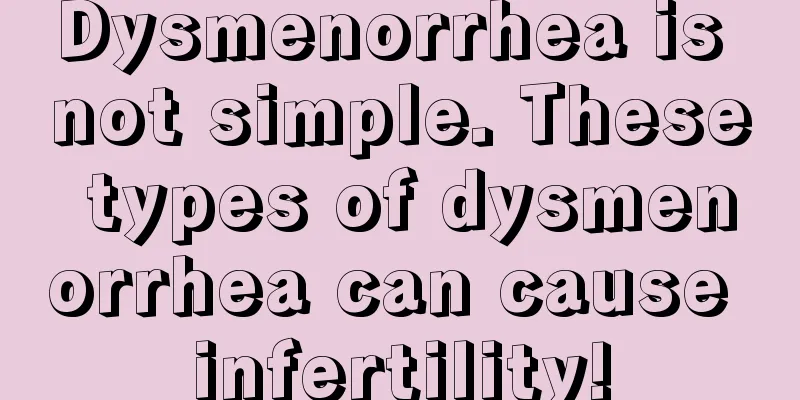Dysmenorrhea is not simple. These types of dysmenorrhea can cause infertility!

|
When it comes to dysmenorrhea, many friends will silently endure the discomfort of those days, thinking that everything will be fine as long as they can get through these days. In fact, dysmenorrhea is not that simple! Abdominal pain during menstruation cannot be cured by just taking some painkillers. Dysmenorrhea not only affects women’s physical health, but in severe cases it can lead to female infertility! In addition to primary dysmenorrhea, there is also secondary dysmenorrhea. Primary dysmenorrhea will not affect conception, while secondary dysmenorrhea is often related to organic pelvic diseases. The following diseases that cause secondary dysmenorrhea will affect conception. Endometriosis: 50% of patients with endometriosis suffer from infertility, and more than 35% of infertility is caused by endometriosis. The main manifestations of endometriosis are secondary dysmenorrhea, progressive aggravation, infertility, discomfort during sexual intercourse, and menstrual abnormalities. Pelvic infection: Mild cases of pelvic inflammatory disease are asymptomatic or have mild symptoms. Common symptoms include lower abdominal pain and increased vaginal discharge. The abdominal pain is persistent and worsens after activity or sexual intercourse. If the condition is serious, fever or even high fever, chills, headache, and lack of appetite may occur. If pelvic inflammatory disease is not diagnosed and treated promptly and correctly, pelvic inflammatory disease sequelae will occur, and the incidence of infertility among its clinical manifestations is 20~30%. The main causes of tubal infertility include pelvic infection, and the microorganisms that cause the infection mainly include Neisseria gonorrhoeae, Chlamydia trachomatis and aerobic and anaerobic bacteria infection of the vagina. Endometrial polyps: Symptoms of endometrial polyps include menorrhagia, menstrual disorders, bleeding during sexual intercourse or intermenstrual bleeding. Symptoms do not correlate with the size, number, or location of the polyps. The incidence of endometrial polyps in infertile women with normal menstruation is 15.6%. The presence of polyps may have the following adverse effects on reproduction: irregular local endometrial bleeding; inflammatory endometrial reaction; blocking sperm transport; affecting embryo implantation, etc. Submucosal uterine fibroids: Prolonged menstrual period and increased menstrual flow are the main manifestations. When submucosal fibroids are accompanied by necrotic infection, there may be irregular vaginal bleeding or bloody purulent discharge. Fibroids and submucosal fibroids that cause deformation of the uterine cavity have a negative impact on reproduction. Drug treatment of fibroids does not improve fertility. Intrauterine adhesion: occurs in pregnancy endometrial damage. Non-pregnancy endometrial damage is seen in abortion, diagnostic curettage, cervical biopsy or polypectomy, after IUD removal, after endometrial resection, etc. Infection can also cause intrauterine adhesion. The incidence of uterine adhesion is positively correlated with the number of induced abortions. Chronic reproductive system inflammation is not treated before surgery, disinfection is not strict during surgery, and sexual intercourse is too early after surgery, which causes infection and promotes the formation of uterine adhesion. The pregnancy prognosis of patients with severe intrauterine adhesions is extremely poor. The main symptoms of intrauterine adhesions are amenorrhea with cyclical abdominal pain, oligomenorrhea, and secondary infertility after artificial abortion or curettage. In summary, the symptoms of dysmenorrhea vary. When you have dysmenorrhea, through the above learning, if you find that you do not have primary dysmenorrhea, you need to go to the hospital for relevant examinations and necessary treatment, especially for the above-mentioned dysmenorrhea that affects conception. Active and effective treatment can not only treat dysmenorrhea, but also clear obstacles for smooth conception! |
<<: The best time to eat apples, are you eating them right?
>>: What tea is the fastest way to lose weight on your legs? These four are preferred
Recommend
Why is the nipple itchy?
Breasts are not only an important symbol for wome...
My baby has a fever. How should I use antipyretics?
Author: Wurikhan People's Hospital of Inner M...
Beware! -- Drug-induced liver injury in children
Drug-induced liver injury (DILI) is one of the mo...
"One man's meat is another man's poison" - On the interaction between grapefruit and drugs
This is the 4553th article of Da Yi Xiao Hu “Eati...
Does withdrawal bleeding cause stomach pain?
Withdrawal bleeding is a physiological phenomenon...
What causes a girl to smell down there?
The common cause of odor in women's private p...
Will atrophic gastritis turn into cancer? What should I do and what should I pay attention to in my daily life?
A friend asked Huazi if he had atrophic gastritis...
What are the symptoms of vaginitis?
As gynecological diseases become more and more co...
A brief description of commonly used intestinal cleansers before colonoscopy
Award-winning works (article category) of the Hea...
eMarketer: Twitter's advertising revenue is expected to reach $139.5 million in 2011, a 210% increase
On September 29, 2011, TechCrunch, a US technolog...
Is it okay to wear seamless bras if you have small breasts?
Many people have very small breasts. When the bre...
Is it still possible to have a baby if you have amenorrhea?
After women experience amenorrhea, it is best not...
What should I do if my girlfriend has period pain?
Almost every young female friend has experienced ...
Precautions after receiving the nine-valent vaccine
The nine-valent HPV vaccine is a major research a...
Can I get my eyebrows embroidered when I'm pregnant?
Pregnancy is a very important period for women be...









